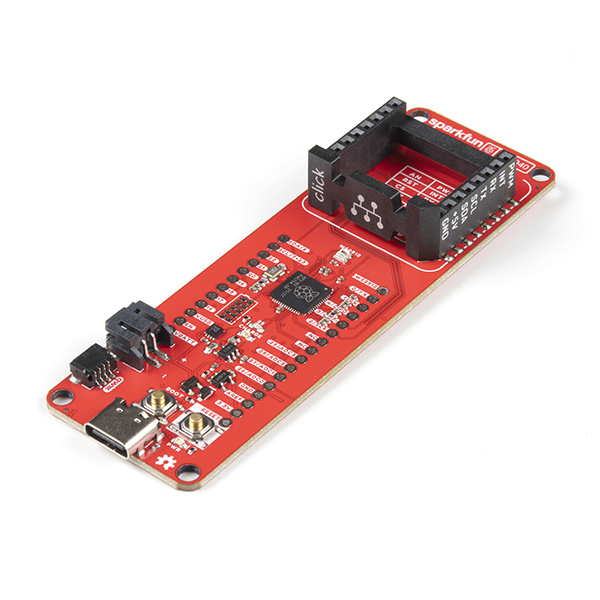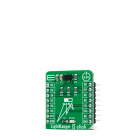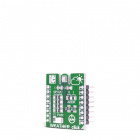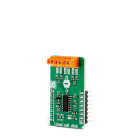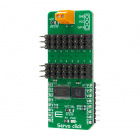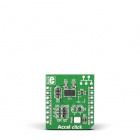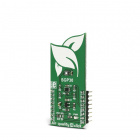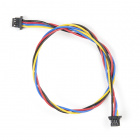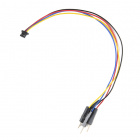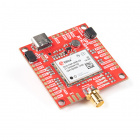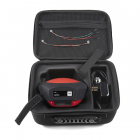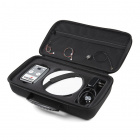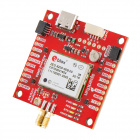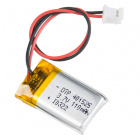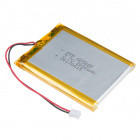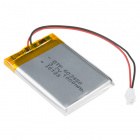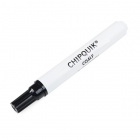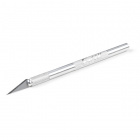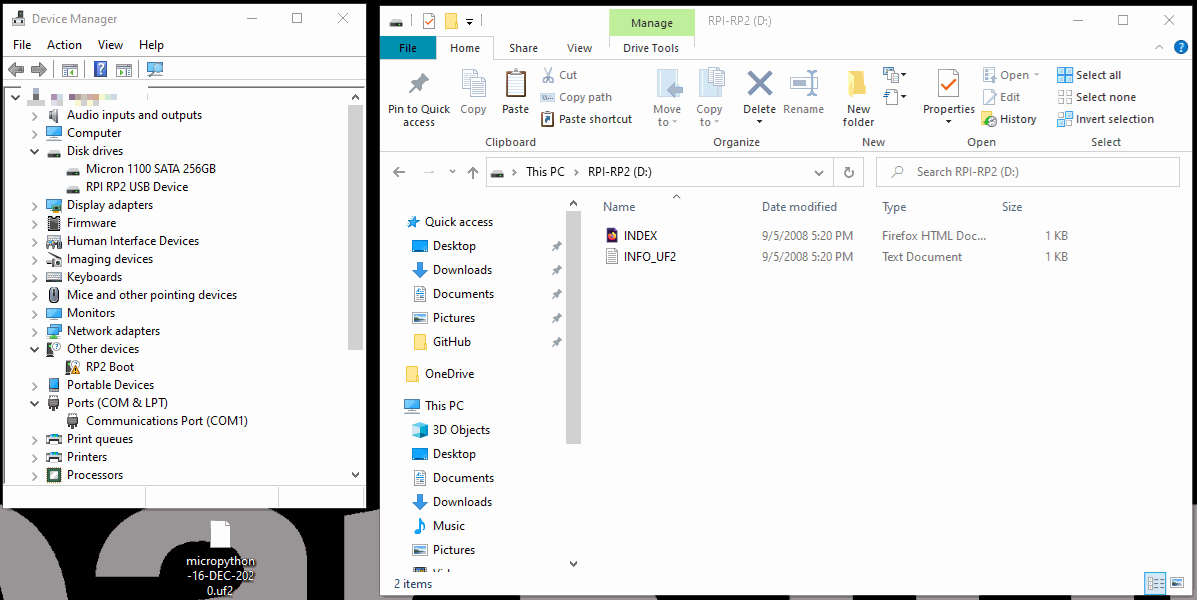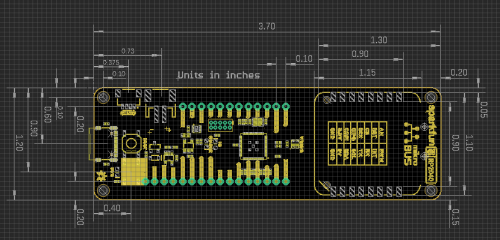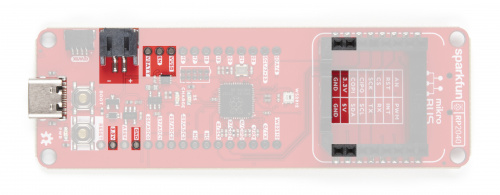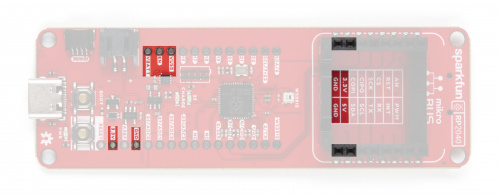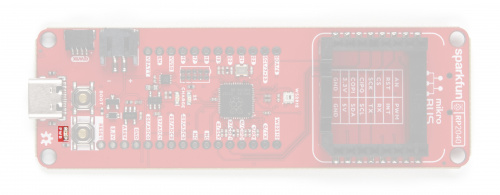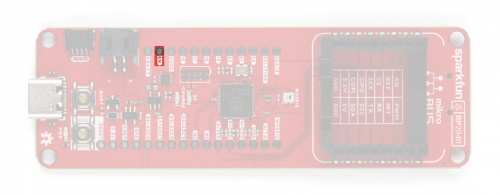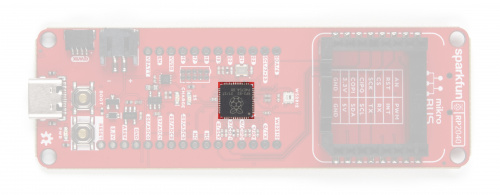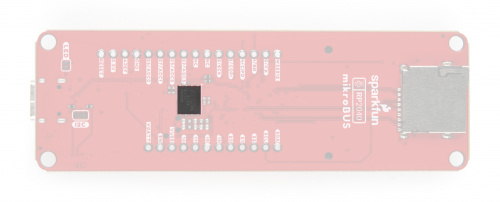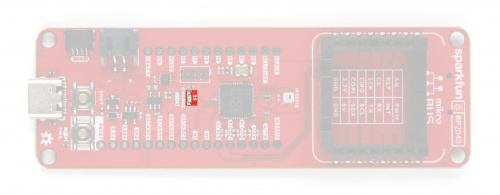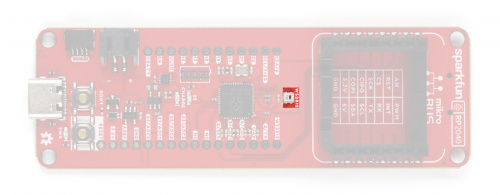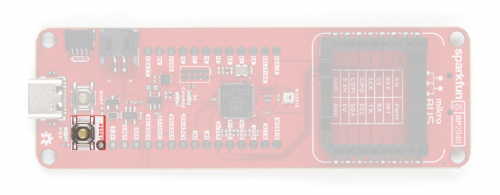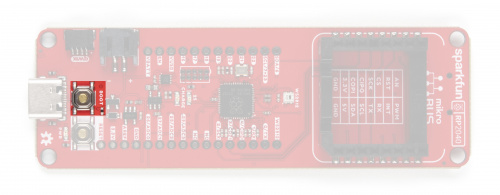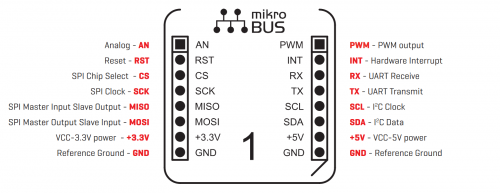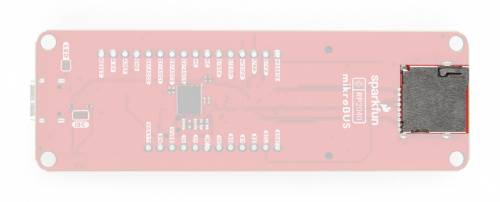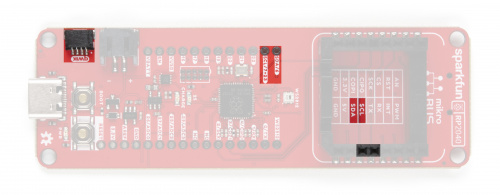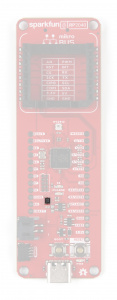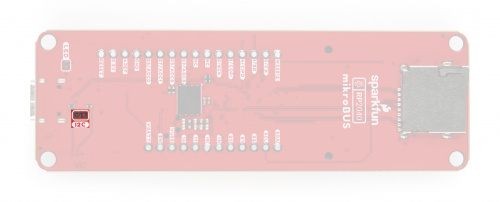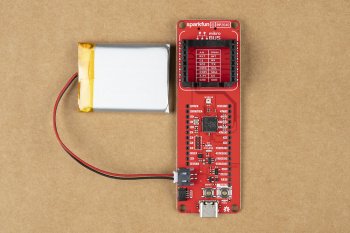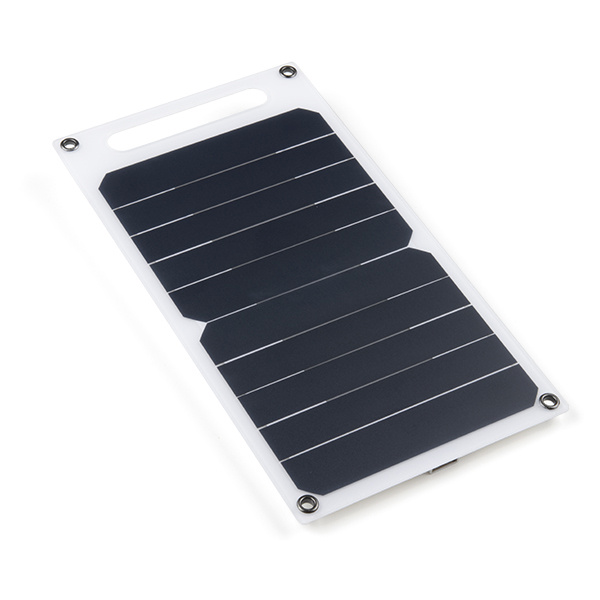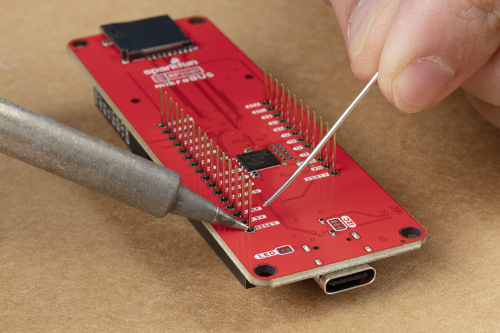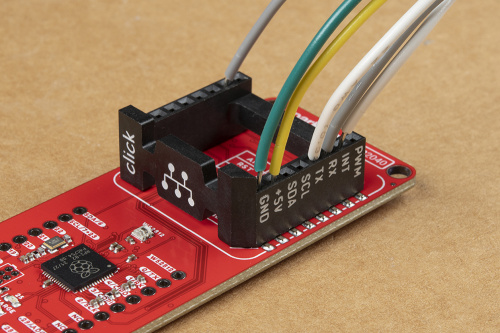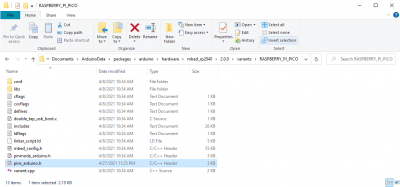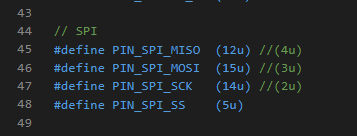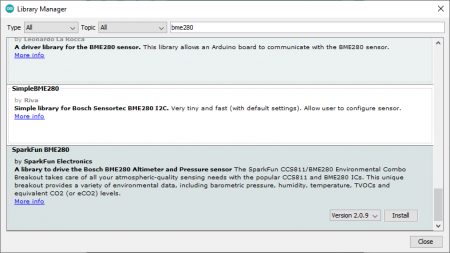RP2040 mikroBUS™ Development Board Hookup Guide
This Tutorial is Retired!
This tutorial covers concepts or technologies that are no longer current. It's still here for you to read and enjoy, but may not be as useful as our newest tutorials.
Introduction
The RP2040 mikroBUS™ Development Board is our latest RP2040 microcontroller (MCU) development board. This new board takes advantage of the Qwiic and the mikroBUS™ ecosystems and allows users to take advantage of the growing number of 94 Qwiic boards and 1079 Click boards™ (as of September 2021) to develop with the Raspberry Pi RP2040 microcontroller.
The Raspberry Pi RP2040 (the first MCU from the Raspberry Pi Foundation) is a low cost, dual-core Arm® Cortex® M0+ microcontroller with 264kB of SRAM, running at 133MHz. It includes USB host functionality, a timer with 4 alarms, a real time counter (RTC), six dedicated IO pins for Quad-SPI flash (supporting execute in place), and thirty multifunction GPIO
(*18 of which are broken out on the board), with the following capabilities:
- Four 12-bit Analogue to Digital Converter (ADC) channels
- Two UART buses
- Two I2C buses
- Two SPI buses
- Up to 16 PWM channels
- Can emulate interfaces such as SD Card and VGA
The mikroBUS™ standard was developed by MikroElektronika and provides a standardized connection to interface with Click boards™.
For more details, check out their blog post on the 1000th Click board™ and the origins of the mikroBUS™ standard and mikroBUS™ standard specifications.
Required Materials
To get started, users will need a few of items listed below. (You may already have a some of these items; read through the guide and modify your cart accordingly.)
Required Hardware
A USB-C cable is needed to connect the RP2040 mikroBUS™ Development Board to a computer.
Click Board™
We recommend purchasing a Click board™ to utilize the mikroBUS™ socket. We also suggest novice users select a Click board™ that is supported with an Arduino library. Otherwise, users will have difficulties programming their board to utilize the associated Click board™. Below, is a sample of the options available in our catalog:
MIKROE Spectrometer Click
SEN-18785MIKROE LightRanger 8 Click
SEN-18803MIKROE Thunder Click
SEN-18821MIKROE Weather Click
SEN-18823MIKROE Load Cell Click
SEN-18824MIKROE Servo Click
ROB-18867MIKROE Accel Click
SEN-18925MIKROE Air Quality 4 Click
SEN-18928Optional Hardware
To connect Qwiic breakout boards for your MicroMod project, Qwiic cables are required.
A single-cell Lithium-ion battery can be connected to the Qwiic Carrier Board for portability.
Lithium Ion Battery - 1Ah
PRT-13813To modify the jumpers, users will need soldering equipment and/or a knife.
Weller WLC100 Soldering Station
TOL-14228Suggested Reading
The MicroMod ecosystem is a unique way to allow users to customize their project to their needs. The Qwiic connect system is a simple method for interfacing with I2C devices. Click on the banners below for more information on each system.
For users who aren't familiar with the following concepts, we also recommend reading the following tutorials before continuing.
Serial Communication
Serial Peripheral Interface (SPI)
Pulse Width Modulation
Logic Levels
I2C
Analog vs. Digital
Processor Interrupts with Arduino
Installing an Arduino Library
Installing Arduino IDE
Installing Board Definitions in the Arduino IDE
RP2040 Thing Plus Hookup Guide
UF2 Bootloader
The RP2040 mikroBUS™ Development Board is easy to program, thanks the UF2 bootloader. With the UF2 bootloader, the RP2040 Thing Plus shows up on your computer as a USB storage device without having to install drivers for Windows 10, Mac, and Linux!
What is UF2?
UF2 stands for USB Flashing Format, which was developed by Microsoft for PXT (now known as MakeCode) for flashing microcontrollers over the Mass Storage Class (MSC), just like a removable flash drive. The file format is unique, so unfortunately, you cannot simply drag and drop any compiled binary or hex file onto the board. Instead, the format of the file must have specific information to tell the processor where the data goes, in addition to the data itself. For more information about UF2, you can read more from the MakeCode blog, as well as the UF2 file format specifiation.
BOOTSEL Mode
Users can enter BOOTSEL mode by holding down the BOOT button, when the USB connection is made to a computer. The board will remain in this mode until it power cycles (happens automatically after uploading a .uf2 firmware file) or the RESET button is pressed. The board will appear as a USB mass storage device under the name RPI-RP2.
BOOT button to enter BOOTSEL mode. Note: As another option, with the USB-C cable already connected to the board and the computer, users can hold down the BOOT button and toggle the RESET button to enter BOOTSEL mode. However, this method does require a little bit of finger dexterity.
Hardware Overview
Note: Users may notice similarities between the RP2040 Thing Plus and the RP2040 mikroBUS™ development board. These boards are nearly identical, apart from the board dimensions and the mikroBUS™ socket. Please refer to the RP2040 Thing Plus hookup guide for more details on the board design.
RP2040 Thing Plus Hookup Guide
Board Dimensions
The RP2040 mikroBUS™ Development Board's pin layout has a feather form factor with a mikroBUS™ socket above. The board dimensions are illustrated in the drawing below.
Power
The RP2040 mikroBUS™ Development Board only requires 3.3V to power the board. However, the simplest method to power the board is through the USB-C connector.
The power pins that are available on the board, are detailed below:
3V3- A regulated 3.3V voltage source (600mA).- Regulated from the USB 5V power and/or battery connection by a AP2112 LDO.
- Used to power the RP2040 MCU, WS2812 RGB LED, W25Q128 16MB flash chip, µSD card slot,
+3.3Vpin of the mikroBUS™ socket, and the Qwiic bus (I2C). - Serves as the reference voltage for the RP2040 ADC (
ADC_VDD). - Pin can also operate as an input from an external power source.
USB- The voltage from the USB-C connector, usually 5V.- Used to provide a regulated 3.3V source through the AP2112 LDO (see above).
- Serves as the power supply for the MCP73831 linear charge management controller to the JST battery connector.
- Serves as the power supply for the
+5Vpin of the mikroBUS™ socket. - Utilizes a P-channel MOSFET to control the power source for the AP2112 LDO.
- Utilizes a BAT20J protection diode for the USB-C connection.
VBAT- The voltage from the JST battery connector; meant for single cell LiPo batteries.- Used to provide a regulated 3.3V source through the AP2112 LDO (see above).
- Connected to the MCP73831 linear charge management controller.
GND- The common ground or the 0V reference for the voltage supplies.
Note: The RP2040 microcontroller has two low power states:
SLEEP- All the processors are asleep and most of the clocks in the chip are stoppedDORMANT- All clocks in the chip are stopped
Power Status LED
The red, POWER LED will light up once 3.3V is supplied to the board; however, for most users, it will light up when 5V is supplied through the USB connection or when a LiPo battery is connected to the JST connector.
POWER status LED indicator. (Click to enlarge) Charging Circuit
The charging circuit utilizes the MCP73831 linear charge management controller and is powered directly from the USB-C connector or USB. The controller is configured for a 500mA charge rate and battery charging is indicated when the yellow, CHG LED. If the charge controller is shutdown or charging is complete, the CHG LED will turn off. For more information, pleas refer to the MCP73831 datasheet.
Power Control
The power source to the AP2112 LDO voltage regulator is controlled by a P-channel MOSFET. In addition, the 3.3V regulated output from the AP2112 is controlled by the enable (EN) pin, broken out on the board. By default, the chip enable pin (EN) is pulled high, to enable the 3.3V output, supply voltage. To disable and shutdown the output voltage from the AP2112, the chip enable pin (EN) needs to be pulled low (i.e. shorted to ground (GND)). For more information, pleas refer to the AP2112 datasheet.
RP2040 Microcontroller
The Raspberry Pi RP2040 is a low-cost, high-performance microcontroller with flexible digital interfaces. It features:
- Dual Arm® Cortex®-M0+ processors, up to 133 MHz
- 264 kB of embedded SRAM in 6 banks
- 6 dedicated IO for additional storage
- Connects to QSPI Flash
- Supports execute in place (XIP))
- 30x 3.3V user-programmable high-speed IO (only 18 are broken out on the board)
- 4x 12-bit 500ksps Analogue to Digital Converter (ADC)
- Various digital peripherals
- 2x UART, 2x I2C, 2x SPI, up to 16 PWM channels
- 1x Timer with 4 alarms, 1x Real Time Counter
- USB 1.1 Host/Device compatible
The processor implements the ARMv6-M Thumb instruction set and provides programmable (multifunction) IO (PIO), which is unique to the RP2040. For more information, pleas refer to the RP2040 datasheet.
USB Functionality
The RP2040 contains a USB 2.0 controller that can operate as either:
- Full Speed device (12 Mbit/s)
- Host that can communicate with both Low Speed (1.5 Mbit/s) and Full Speed devices. This includes multiple downstream devices connected to a USB hub.
USB Mass Storage Interface
The Bootrom provides a standard USB bootloader that emulates a writeable drive available for loading firmware to the RP2040
using UF2 files. Once a UF2 file is loaded onto the drive, it is written to the flash or RAM and the device automatically reboots.
- The bootrom source code is hosted on GitHub.
RPI-RP2 Drive
The RP2040 appears as a standard 128MB flash drive named RPI-RP2 formatted as a single partition with FAT16. There
are only ever two actual files visible on the drive specified.
INFO_UF2.TXT- contains a string description of the UF2 bootloader and version.INDEX.HTM- redirects to information about the RP2040 device.
.uf2 file is written to the device however, the special contents are recognized and data is written to specified locations in RAM or Flash. On the completed download of an entire valid .uf2 file, the RP2040 automatically reboots to run the newly downloaded code.Flash Memory
RP2040 has embedded ROM and SRAM, and access to external flash via a QSPI interface. On the RP2040 mikroBUS™ development board, an additional 16MB (128Mbit) of 133MHz memory is provided by a W25Q128JVPIM chip. The flash memory is required for the RP2040 to store program code, which it can boot and run from through its dedicated QSPI pins:
- Pin 52:
CLK - Pin 56:
CS - Pin 53:
DATA 0/DI - Pin 55:
DATA 1/DO - Pin 54:
DATA 2/WP - Pin 51:
DATA 3/HOLD
0x10000000.Indicator LEDs
There are 4 indication LEDs on the RP2040 mikroBUS™ development board for:
PWR: Power (Red)CHG: Battery Charging (Yellow)25:GPIO 25(Blue)WS2812:GPIO 08(RGB)
Power LED
The red, PWR LED will light up once 3.3V is supplied to the board. For most users, it will light up when 5V is supplied through the USB connection and/or when a LiPo battery is attached to the JST connector.
PWR status LED indicator. (Click to enlarge) Battery Charging LED
The yellow, CHG LED will light while a battery is being charged through the charging circuit. The LED will be off when no battery is present (*or dimmed), when the charge management controller is in standby (after the battery charging has been completed), or when the charge management controller is shutdown (thermal shutdown or when the input voltage is lower than the battery voltage). The LED will be on when the charge management controller is in the process of charging the battery. For more information, please refer to the MCP73831 datasheet.
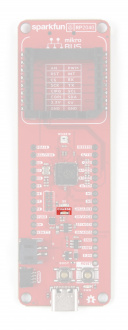
The battery charging (
CHG) LED indicator on the RP2040 mikroBUS™ development board. (Click to enlarge)
| Charge Cycle State | STAT1 |
|---|---|
Shutdown
|
Off (High Z) |
| No Battery Present* | Dimmed (High Z) |
| Charge Complete – Standby | Off (H) |
| Preconditioning | On (L) |
| Constant-Current Fast Charge | On (L) |
| Constant Voltage | On (L) |
*The charge LED may appear dimmed due a trickle charge from the MAX17048 fuel gauge. Normally, the LED should be OFF.
Status LED
The blue, 25 LED is typically used as a test or status LED to make sure that a board is working or for basic debugging. This indicator is connected to GPIO 25.
25) LED indicator on the RP2040 mikroBUS™ development board. (Click to enlarge) WS2812 RGB LED
The WS2812 RGB LED is controlled with a 24-bit (GRB) data signal. This indicator is connected to GPIO 08 and the digital output pin from the LED is broken out as the WS2812 pin on the board. For more information, please refer to the WS2812C datasheet.
WS2812 LED indicator on the RP2040 mikroBUS™ development board. (Click to enlarge) Buttons
The RP2040 mikroBUS™ dev. board has two buttons on the board for uploading and running code.
Reset Button
The RESET button is connected to the reset pin and is used to reset the microcontroller without needing to unplug the board.
RESET button on the RP2040 mikroBUS™ development board. (Click to enlarge) Boot Button
The BOOT button is used to force the board into BOOTSEL mode, by holding down the BOOT button while connecting the board to a computer through its USB-C connector. Users can then, upload firmware files to the emulated RPI-RP2 USB mass storage device.
BOOT button on the RP2040 mikroBUS™ development board. (Click to enlarge) BOOTSEL Mode: Users can enter BOOTSEL mode by holding down the BOOT button, when the USB connection is made to a computer. The board will remain in this mode until it power cycles (happens automatically after uploading a .uf2 firmware file) or the RESET button is pressed. The board will appear as a USB mass storage device under the name RPI-RP2.
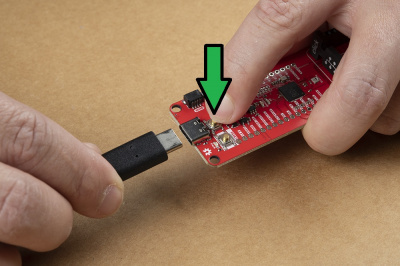
Hold down
BOOT button to enter BOOTSEL mode on The SparkFun Thing Plus - RP2040. (Click to enlarge)
MikroBUS™ Socket
The most significant feature of this board, is the addition of the MikroBUS™ socket, which provides a drop-in interface for MikroElectronka&apo;s ecosystem of Click boards™ (over 1079 as of September 2021).
The mikroBUS™ socket comprises a pair of 8-pin female headers with a standardized pin configuration. The pins consists of three groups of communications pins (SPI, UART and I2C), six additional pins (PWM, Interrupt, Analog input, Reset and Chip select), and two power groups (3.3V and 5V).
GPIO 02:SCKGPIO 03:MOSI(COPI)GPIO 04:MISO(CIPO)GPIO 05:CS
GPIO 06:SDAGPIO 07/23:SCL
GPIO 0:TXGPIO 01:RX
GPIO 13:RSTGPIO 16:PWMGPIO 17:INTGPIO 26:AN
*For more information about the mikroBUS™ socket, click here for the mikroBUS™ standard specifications.
µSD Slot
MOSI signal on a controller has been replaced with the title SDO. Please refer to this announcement on the decision to deprecate the MOSI/MISO terminology and transition to the SDO/SDI naming convention.
The RP2040 mikroBUS™ development board includes an µSD card slot. This is great for data logging applications or storing files. The µSD card slot is connected to the following dedicated GPIO:
GPIO 09:DATA 3/CSGPIO 10:DATA 2GPIO 11:DATA 1GPIO 12:DATA 0/CIPO(or Peripheral'sSDO)GPIO 14:CLK/SCKGPIO 15:CMD/COPI(or Peripheral'sSDI)
Primary I2C Bus
A (battery) fuel gauge and a Qwiic connector are attached to the primary I2C bus I2C1. The primary I2C bus for this board utilizes the GPIO connections, detailed in the table below:
| Connection | VDD |
GND |
SCL |
SDA |
|---|---|---|---|---|
| Pin Number | 3.3V | GND |
Pin 9 Pin 35 |
Pin 8 |
| GPIO | 3.3V | GND |
GPIO 07GPIO 23
|
GPIO 06 |
Note: The clock line of the I2C bus is tied between pins 9 and 35 (GPIO 07 and GPIO 23). This allows GPIO 16 - GPIO 23 to be aligned on the board's edge, for a consecutive, eight pin bus; useful for things like HDMI.
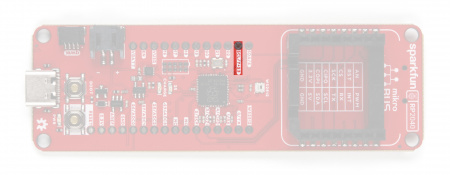
Shared pin for
GPIO 07 and GPIO 23 on the RP2040 mikroBUS™ development board. (Click to enlarge)
*Since the two GPIO pins are tied together, they cannot operate simultaneously.
Battery Fuel Gauge
The MAX17048 fuel gauge measures the approximate charge or discharge rate, state of charge (SOC) (based on ModelGauge algorithm), and voltage of a connected battery. Additionally, there is a configurable alert pin functionality for low SOC, 1% SOC, reset, overvoltage, or undervoltage. For more information, pleas refer to the MAX17048 datasheet.
| I2C Address |
0x36 (7-bit) 0x6C (write)/0x6D (read) |
| Voltage Measurement |
Range: 2.5 - 5 V Precision: ±7.5 mV/Cell Resolution 1.25 mV/Cell |
| Current Consumption |
Sleep: .5 - 2 µA Hibernate: 3 - 5 µA Active: 23 - 40 µA |
| Alert Indicators: |
Low SOC 1% Change in SOC Battery Undervoltage/Overvoltage VRESET Alert |
| Alert Pin | GPIO 24 |
Qwiic Connector
A Qwiic connector is provided for users to seamlessly integrate with SparkFun's Qwiic Ecosystem.
What is Qwiic?
The Qwiic system is intended a quick, hassle-free cabling/connector system for I2C devices. Qwiic is actually a play on words between "quick" and I2C or "iic".
Features of the Qwiic System
Keep your soldering iron at bay.
Cables plug easily between boards making quick work of setting up a new prototype. We currently offer three different lengths of Qwiic cables as well as a breadboard friendly cable to connect any Qwiic enabled board to anything else. Initially you may need to solder headers onto the shield to connect your platform to the Qwiic system but once that’s done it’s plug and go!

Qwiic cables connected to Spectral Sensor Breakout
Minimize your mistakes.
How many times have you swapped the SDA and SCL wires on your breadboard hoping the sensor will start working? The Qwiic connector is polarized so you know you’ll have it wired correctly, every time, from the start.
The PCB connector is part number SM04B-SRSS (Datasheet) or equivalent. The mating connector used on cables is part number SHR04V-S-B or equivalent. This is a common and low cost connector.
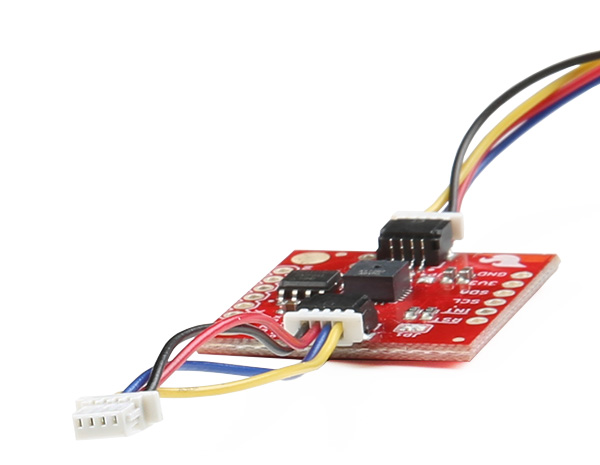
1mm pitch, 4-pin JST connector
Expand with ease.
It’s time to leverage the power of the I2C bus! Most Qwiic boards will have two or more connectors on them allowing multiple devices to be connected.
I2C Jumper
Cutting the I2C jumper will remove the 4.7kΩ pull-up resistors from the I2C bus. If you have many devices on your I2C bus you may want to remove these jumpers.
Hadware Assembly
USB Programming
The USB connection is utilized for programming and serial communication. Users only need to plug their RP2040 mikroBUS™ development board into a computer using a USB-C cable.
BOOTSEL Mode
Users can enter BOOTSEL mode by holding down the BOOT button, when the USB connection is made to a computer. The board will remain in this mode until it power cycles (happens automatically after uploading a .uf2 firmware file) or the RESET button is pressed. The board will appear as a USB mass storage device under the name RPI-RP2.
BOOT button to enter BOOTSEL mode on the RP2040 mikroBUS™ development board. (Click to enlarge) Battery
For remote applications, the RP2040 Thing Plus can be powered through its 2-pin JST battery connector. Additionally, users may be interested in utilizing a solar panel and USB-C cable to recharge their battery.
Note: DO NOT remove batteries by pulling on their wires. Instead, it is recommended that pair of dikes (i.e. diagonal wire cutters), pliers, or tweezers be used to pull on the JST connector housing, to avoid damaging the battery wiring.
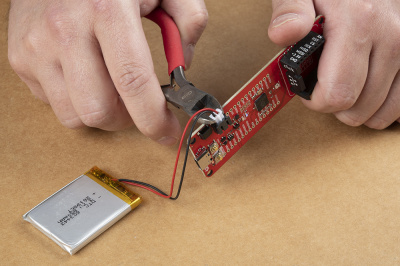
Using a pair of dikes to disconnect a battery. (Click to enlarge)
Headers
The pins for the RP2040 mikroBUS™ development board are broken out to 0.1"-spaced pins on the outer edges of the board. When selecting headers, be sure you are aware of the functionality you need. If you have never soldered before or need a quick refresher, check out our How to Solder: Through-Hole Soldering guide.
The Feather Stackable Header Kit is a great option as it allows users to stack shields (w/ Feather footprint) or it can be placed on the a breadboard; while, the pins are still accessible from the female/male headers.
mikroBUS™ Socket
The RP2040 mikroBUS™ development board has a mikroBUS™ Socket, where a Click board™ can be inserted.
Note: To remove a Click board™, slowly and carefully wiggle it out of the mikroBUS™ socket to avoid bending the header pins on your Click board™.
The header also allows users to connect jumper wires to devices that may not have the mikroBUS™ pin layout to interface with.
Qwiic Devices
The Qwiic system allows users to effortlessly prototype with a Qwiic compatible I2C device without soldering. Users can attach any Qwiic compatible sensor or board, with just a Qwiic cable. (*The example below, is for demonstration purposes and is not pertinent to the board functionality or this tutorial.)
Software Overview
The Raspberry Pi foundation provides excellent documentation for the RP2040 on their website. This includes information for users to program the RP204 with MicroPython and C/C++ through the Pico SDK. Arduino, has also announced the release of their Mbed RP2040 Arduino core. The instructions below, are meant to help users setup and utilize the RP2040 mikroBUS™ Development Board with the Arduino IDE.
Note: We recommend that users program their RP2040 mikroBUS™ development board through the Arduino IDE. Additionally, we recommend that users select Click boards™ based on available and compatible Arduino libraries.
If users wish to use another development platform/environment or utilize a Click board™ without an Arduino library, it is expected that the user is experienced enough port the necessary resources on their own.
For utilizing the Pico SDK (C/C++) and MicroPython, users can follow the instructions provided by the Raspberry Pi Foundation documentation:
- Getting Started with Raspberry Pi Pico (PDF)
- Raspberry Pi Pico C/C++ SDK User Manual (PDF)
- Raspberry Pi Pico Python SDK User Manual (PDF)
To utilize the mikroSDK™, users can refer to instructions provided by MikroElektronika:
- Blog: mikroSDK - Learn what it is and how to use it
- Reference Manual
- User Manual
- mikroSDK™ Libraries
- GitHub Repository
Arduino IDE
Most users will be familiar with the Arduino IDE and it's use. As a point of reference for professional developers who aren't aware, the Arduino IDE is an open-source development environment, written in Java, that makes it easy to write code and upload it to a supported board. For more details, feel free to check out the Arduino website.
To get started with the Arduino IDE, check out the following tutorials:
Installing an Arduino Library
What is an Arduino?
Installing Arduino IDE
Installing Board Definitions in the Arduino IDE
Installing the RP2040 Board Definition
Install the latest Arduino Mbed OS RP2040 board definitions in the Arduino IDE. Users unfamiliar with the board definition installation process can reference our tutorial below.
Installing Board Definitions in the Arduino IDE
Installation Instructions:
- Search for
RP2040in the Boards Manager.
Arduino Mbed OS RP2040 listed in the Boards Manager. (Click to enlarge) - To complete the installation process, selected the Arduino Mbed OS RP2040 core and click on the INSTALL button that appears in the lower, right-hand corner. The board definition and upload tools will be installed automatically; users will notice that this may take a while.
Note: Users may need to disable their anti-virus software when installing the Arduino Mbed OS RP2040 board definition. We ran into issues, where the installation of the upload tools for the Arduino core were blocked by the anti-virus software. Arduino is already aware of the issue, they are working to get their files white-listed. For more information, users can reference this GitHub issue. Programming Tip:
The board may not show up on a COM port, if users who have already programmed their board through a different method. A simple solution is to:
- Download the
picoprobe.uf2file from the Raspberry Pi foundation's Pico board documentation page - Copy the
picoprobe.uf2firmware file to the board (while it is inBOOTSELmode) - If the board isn't automatically listed on a COM port users should reset (or unplug and re-plug in the board to the computer)
Note: If users have the Arduino IDE's Tools drop down menu open looking for a new COM port to be added, the Arduino IDE doesn't automatically repopulate and update the listed COM ports. To update the available COM ports list, users should close and then re-open the Tools drop down menu and navigate to the available COM ports.- Download the
Note: Users trying to access the SD card slot will need to modify the pins_arduino.h file to reconfigure the SPI bus pins. However, this will make the SPI bus inaccessible through the breakout pins (when utilizing the SPI library).
On a Windows 10 computer, with the Arduino IDE installed through the App store, the location of the
pins_arduino.hfile is:C:\Users\<username>\Documents\ArduinoData\packages\arduino\hardware\mbed_rp2040\<package_version>\variants\RASPBERRY_PI_PICO
pins_arduino.hfile in theRASPBERRY_PI_PICOfolder. (Click to enlarge)Users will need to modify lines 45 - 47 of the
pins_arduino.hfile to the following:// SPI #define PIN_SPI_MISO (12u) //(4u) #define PIN_SPI_MOSI (15u) //(3u) #define PIN_SPI_SCK (14u) //(2u)
Line modifications to thepins_arduino.hfile. (Click to enlarge)
earlephilhower has ported an unofficial Arduino core for the RP2040, which is based on the Pico SDK. This is useful for customers who want the functionality of the Pico SDK in the Arduino IDE. Installation instructions are available in the GitHub repository.
Arduino Example
Note: The example for this tutorial assumes users have the latest version of the Arduino IDE installed. If this is your first time using Arduino, please review our tutorial on installing the Arduino IDE. If you have not previously installed an Arduino library, please check out our installation guide:
Installing an Arduino Library
For this example, users will need a USB-C cable, a RP2040 mikroBUS development board, a Weather Click, and access to a computer with the Arduino IDE installed.
MIKROE Weather Click
SEN-18823Hardware assembly is straight forward, insert the Click board into the mikroBUS socket and then connect the RP2040 development board to the computer in BOOTSEL mode.
On the computer, users should have the MBed OS RP2040 Arduino core installed through the Board Manager. The Weather Click utilizes the BME280 PTH sensor; therefore, users will need to install a compatible Arduino library in the Arduino IDE. We recommend the SparkFun BME280 Arduino Library.
Once installed, users will have access to basic examples for the sensor. The examples can be found under the File > Examples > SparkFun BME280 menu options. We recommend trying the Example1_BasicReadings sketch first. Users will need to modify the sketch in the setup() loop for it to function properly:
language:c
Serial.begin(115200);
while (!Serial){
; // wait for serial port
}
// Set I2C address
mySensor.settings.I2CAddress = 0x76;
Serial.println("Reading basic values from BME280");
- The while statement allows the RP2040 to sync properly with a terminal emulator
- The default I2C address of the library is 0x77; however, it must be changed to the address configured on the Weather Click
Once these changes have been made, users can upload the program. After the upload process has completed, users can open the Serial Monitor to see the sensor data:
Resources and Going Further
For more on the RP2040 mikroBUS™ development board, check out the links below:
- Schematic
- Eagle Files
- Board Dimensions
- Hookup Guide
- Qwiic Info Page
- GitHub Hardware Repository
- Software (SDK) Documentation:
- Online SDK Documentation
- Raspberry Pi Pico C/C++ SDK - A guide on the libraries and tools for C++ development on RP2040 microcontrollers
- Raspberry Pi Pico Python SDK - A guide on the MicroPython environment for RP2040 microcontrollers
- Hardware Component Information:
- Software Development Platforms for the RP2040:
- MicroPython
- Example code to accompany the Get Started with MicroPython on Raspberry Pi Pico book
- Pico C/C++ SDK
- Example codes
- Beta Libraries
- Example code for the beta libraries
- Tools and Resources:
- RP2040 Boot ROM - Source code for the USB mass storage device emulation
- Picotool - Inspecting RP2040 binaries in BOOTSEL mode
- Debugging Probe Configuration
- OpenOCD Debugger
- pico-project-generator - GUI tool to automatically generate a Pico C/C++ SDK project
- UF2 Files- Just drag-and-drop onto your RP2040 board
- C/C++ Files:
- MicroPython Files:
- Utility Files:
microcontroller
- Debugging w/ picoprobe - Debugging with another RP2040 microcontroller
- Reset flash memory - Clears flash memory from board
- MicroPython
